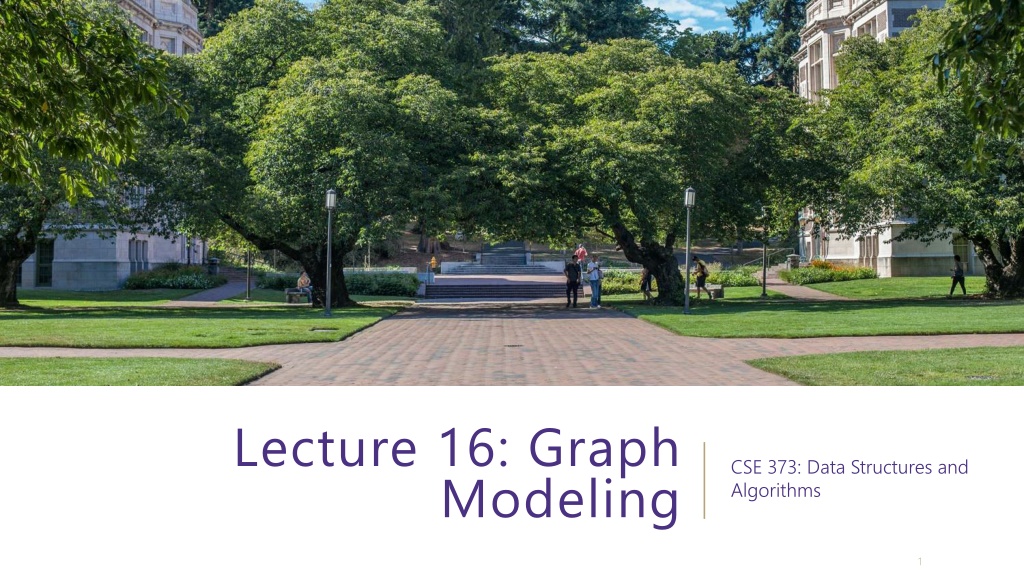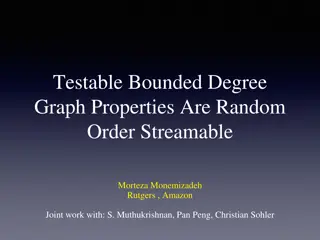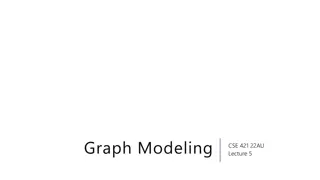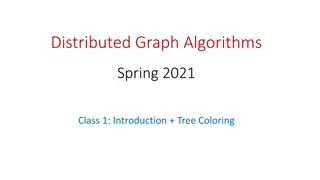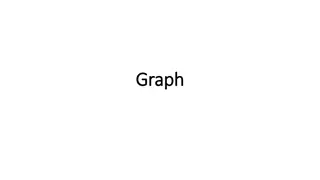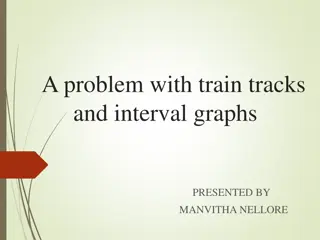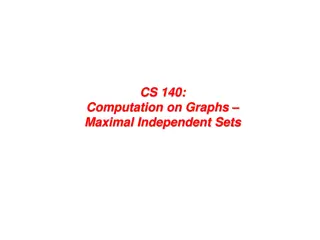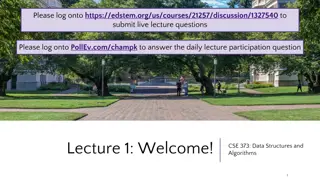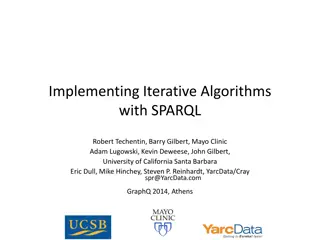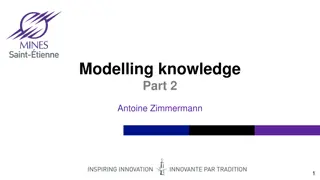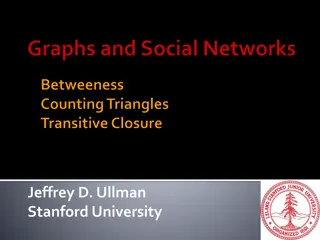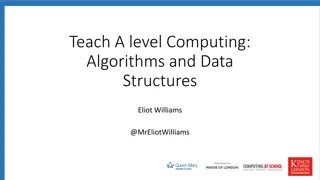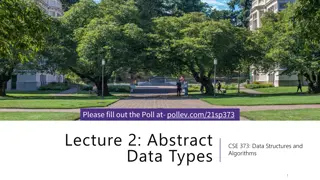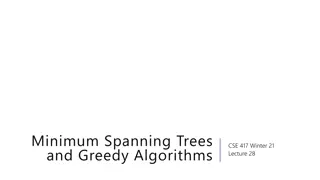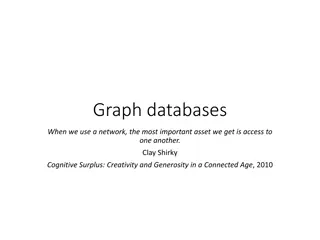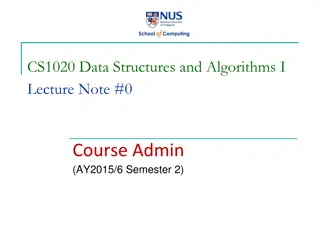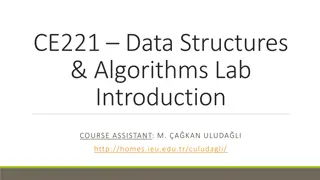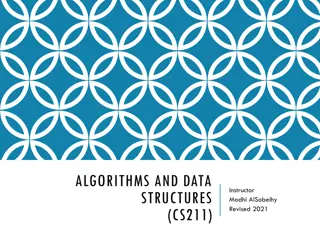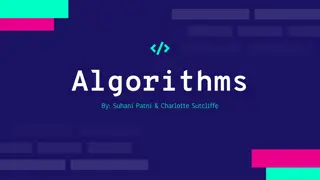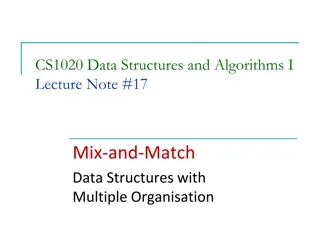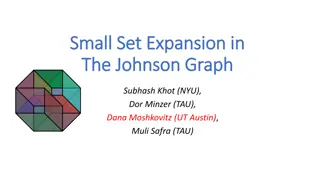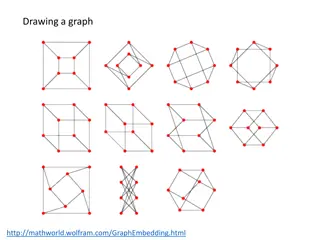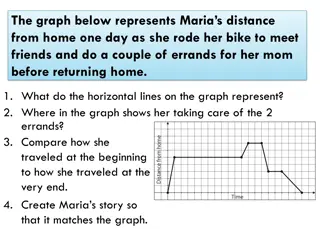Graph Modeling in Data Structures and Algorithms
Exploring graph modeling in CSE 373, this lecture covers topics such as using BFS for finding shortest paths, limitations of BFS on weighted graphs, and the introduction of Dijkstra's algorithm for weighted graphs. It emphasizes the importance of considering edge weights in determining traversal order for finding the shortest path. Announcements regarding project deadlines and upcoming sessions are also highlighted.
Download Presentation

Please find below an Image/Link to download the presentation.
The content on the website is provided AS IS for your information and personal use only. It may not be sold, licensed, or shared on other websites without obtaining consent from the author. Download presentation by click this link. If you encounter any issues during the download, it is possible that the publisher has removed the file from their server.
E N D
Presentation Transcript
Lecture 16: Graph Modeling CSE 373: Data Structures and Algorithms 1
Announcements project 3 due (feedback quiz canvas for extra credit) exercise 3 due friday - note on N vs R and P: please actually use the R and P variables if the runtime is actually based on the number of possible reaction types or number of possible persons. You use N (the normal variable) bc there are two factors here if you write N, we can t tell which one you mean so it s not correct. project 4 out later today/maybe tomorrow morning, we re pushing for tonight though lots of good lecture questions from Monday check out Piazza if you want to see those! Post-CSE 373 Pathways session Saturday 6pm PDT - technical interviews / applying for software jobs / how CSE 373 fits in - Q&A with TAs - recorded in case you can t make it CSE 373 SP 18 - KASEY CHAMPION 2
Review from last time BFS can be used to find shortest paths (path length = # of edges) for unweighted graphs, guaranteed to work because it traverses level by level BFS can be used by keeping track of a predecessor edge (the edge that led to each vertex when we found it for the first time) and if you drew out all of those at the end, you d see those edges represent the Shortest Path Tree (the short path from the source vertex to all the other vertices) BFS shortest paths doesn t work on weighted graphs (paths lengths = sum of the edge weights along the path) because BFS s traversal order doesn t take into account weights. We can use the edge weights (total distance) to figure out the exact order to visit things in so our algorithm is correct Dijkstra s algorithm = this differently ordered traversal / algorithm to find the shortest path on weighted graph Dijkstra s pseudocode / in English (it s pretty similar to BFS shortest paths) CSE 373 SP 18 - KASEY CHAMPION 3
Review from last time BFS shortest paths doesn t work on weighted graphs (paths lengths = sum of the edge weights along the path) because BFS s traversal order doesn t take into account weights. We can use the edge weights (total distance) to figure out the exact order to visit things in so our algorithm is correct. ? ? ? b 4 ? a ? c 6 Idea: when choosing the next node to process next, choose the next smallest distanced node that you know. This should give you the flexibility to be comprehensive about your search / traversal. In the above example, imagine that after we finish processing A (record that there are possible distances of 4 to b and 6 to c) we want to figure out which node we should process next. Without analyzing all the paths coming out from B and C, we know that since the distance to b is smaller, there s a possibility b could have a better shortest path that ends up leading to c (or other nodes) that we d want to incorporate and propagate that information. CSE 373 SP 18 - KASEY CHAMPION 4
Another example of Dijkstras ordering 1 1 1 1 1 1 1 a b 1 1 c d e f g h j i 500 BFS processing in level order would make sure the things at level 1 away (b and j) both get processed / completed before nodes at level 2 +. Dijkstra s processing in distance order would visit B and see that the distance to C is only 2, which is still smaller than 500. Hmmm there might still be a better path to J (which we propose has distance 500) if we keep going this way. Repeat for C D, distance of 3 still less than 500, so it s possible and we should look at D first. To summarize: Dijkstra s algorithm will visit things in next-closest-distance order to make sure we re comprehensive (just like how BFS goes level by level, we go distance by distance) CSE 373 SP 18 - KASEY CHAMPION 5
Review from last time BFS can be used to find shortest paths (path length = # of edges) for unweighted graphs, guaranteed to work because it traverses level by level BFS can be used by keeping track of a predecessor edge (the edge that led to each vertex when we found it for the first time) and if you drew out all of those at the end, you d see those edges represent the Shortest Path Tree (the short path from the source vertex to all the other vertices) BFS shortest paths doesn t work on weighted graphs (paths lengths = sum of the edge weights along the path) because BFS s traversal order doesn t take into account weights. We can use the edge weights (total distance) to figure out the exact order to visit things in so our algorithm is correct Dijkstra s algorithm = this differently ordered traversal / algorithm to find the shortest path on weighted graph Dijkstra s pseudocode / in English (it s pretty similar to BFS shortest paths) CSE 373 SP 18 - KASEY CHAMPION 6
Dijkstras algorithm (pseudocode + English) - propose all the estimated distances to all nodes is infinity, except for the start which is 0 - start at your start vertex to be the current vertex - for the current vertex, look at all of the outgoing neighbors/their edges. If the distance to the current node + that edge weight is smaller than the proposed estimated distance for that neighbor, relax the neighbor node (update the proposed estimated distance and predecessor edge). - update the current vertex to be the vertex w the next smallest estimated distance that hasn t been processed Dijkstra(Graph G, Vertex source) initialize distances to mark source as distance 0 mark all vertices unprocessed while(there are unprocessed vertices){ let u be the closest unprocessed vertex foreach(edge (u,v) leaving u){ if(u s dist+weight(u,v) < v s dist){ v s dist = u.dist+weight(u,v) v s predecessor = (u,v) } } mark u as processed } 2 differences from BFS pseudocode: - let u be the closest unprocessed vertex (not going necessarily by level order anymore) - checking if the current distance + weight is better than what we ve seen so far (BFS assumes its correct the first time it discovers a node, but Dijkstra s has the potential to update to a better distance later, so we check if that s the case) relax 7
Dijkstras Algorithm Distance Vertex s w x u v t Predecessor Processed Dijkstra(Graph G, Vertex source) initialize distances to mark source as distance 0 mark all vertices unprocessed while(there are unprocessed vertices){ let u be the closest unprocessed vertex foreach(edge (u,v) leaving u){ if(u s dist+weight(u,v) < v s dist){ v s dist = u s dist+weight(u,v) v s predecessor = (u,v) } } mark u as processed } 1 w x 1 1 t u v s 1 1 20 CSE 373 19 SU - ROBBIE WEBER
Dijkstras Algorithm Vertex Distance s w x u v t Predecessor -- (s,w ) (w, x) (s,u) (x, u) (u, v) (v, t) Processed Yes Yes Yes Yes Yes Yes 0 1 2 20 3 4 5 Dijkstra(Graph G, Vertex source) initialize distances to mark source as distance 0 mark all vertices unprocessed while(there are unprocessed vertices){ let u be the closest unprocessed vertex foreach(edge (u,v) leaving u){ if(u s dist+weight(u,v) < v s dist){ v s dist = u s dist+weight(u,v) v s predecessor = (u,v) } } mark u as processed } 1 w x 1 1 t u v s 1 1 20 CSE 373 19 SU - ROBBIE WEBER
Dijkstras Pseuodocode Dijkstra(Graph G, Vertex source) Min Priority Queue ADT initialize distances to mark source as distance 0 state Set of comparable values - Ordered by priority mark all vertices unprocessed while(there are unprocessed vertices){ Huh? let u be the closest unprocessed vertex behavior peek() find the element with the smallest priority foreach(edge (u,v) leaving u){ if(u s dist+weight(u,v) < v s dist){ v.dist = u.dist+weight(u,v) insert(value) add new element to collection v.predecessor = (u,v) } removeMin() returns and removes element with the smallest priority } mark u as processed } CSE 373 19 SU - ROBBIE WEBER 10
Dijkstras Pseuodocode Dijkstra(Graph G, Vertex source) Min Priority Queue ADT initialize distances to mark source as distance 0 state Set of comparable values - Ordered by priority mark all vertices unprocessed initialize MPQ as a Min Priority Queue, add source How? while(there are unprocessed vertices){ behavior peek() find the element with the smallest priority u = MPQ.removeMin(); foreach(edge (u,v) leaving u){ if(u s dist+weight(u,v) < v s dist){ insert(value) add new element to collection v.dist = u.dist+weight(u,v) v.predecessor = (u,v) removeMin() returns and removes element with the smallest priority } } mark u as processed } CSE 373 19 SU - ROBBIE WEBER 11
What are the high-level differences between using BFS and Dijkstra s algorithm? findShortestPathsTree(G weightedGraph, V start) { Map<V, E> edgeToV = empty map Map<V, Double> distToV = empty map findShortestPathsTree(G unweightedGraph, V start) { Map<V, E> edgeToV = empty map Map<V, Double> distToV = empty map Queue<V> perimeter = empty queue Set<V> discovered = empty set PQ<V> orderedPerimeter = empty pq initialize all distTo's to so the best paths can be updated if any path is found to that vertex orderedPerimeter.add(start, 0); distTo.put(start, 0.0); perimeter.add(start); distTo.put(start, 0.0); while (!orderedPerimeter.isEmpty()) { V from = orderedPerimeter.removeMin(); for (E e : weightedGraph.outgoingEdgesFrom(from)) { V to = e.to(); double oldDist = distTo.get(to); double newDist = distTo.get(from) + e.weight(); if (newDist < oldDist) { edgeToV.put(to, e); distToV.put(to, newDist); if (pq contain to) { orderedPerimeter.changePriority(to, newDist); } else { orderedPerimeter.add(to, newDist); } } } } } while (!perimeter.isEmpty()) { V from = perimeter.remove(); for (E e : unweightedGraph.outgoingEdgesFrom(from)) { V to = e.to(); if (!discovered.contains(to)) { edgeTo.put(to, e); distTo.put(to, distTo(from) + 1); perimeter.add(to); discovered.add(to) } } } } Dijkstra s to find shortest paths tree (use this for p4) BFS to find shortest paths tree 12
What are the high-level differences between using BFS and Dijkstra s algorithm? BFS to find shortest paths Dijkstra s to find shortest paths only on unweighted graphs (breaks on weighted graphs) works on weighted graphs Dijkstra s iterates in priority order, prioritizing processing nodes with the next smallest estimated distance (so that we get that guarantee that we re looking at correct information). BFS iterates in level order, ordering in-between levels is not important by default. So Dijkstra s uses a PriorityQueue as it s internal data structure to keep track of the ordering. So BFS uses a Queue as it s internal data structure to keep track of the ordering. Overall: - both produce an SPT (the set of edges used to find the shortest path to every vertex) - both can be used on undirected or directed graphs - they re really similar and Dijkstra s just has a few more steps than BFS, so if you re confused, start with understanding BFS shortest paths and then after you feel comfortable with that, tackle practicing / understanding Dijktra s. CSE 373 SP 18 - KASEY CHAMPION 13
Questions? CSE 373 SP 18 - KASEY CHAMPION 14
BFS/DFS runtime All of the data structure operations (remove, add, contains) are all constant runtime and so are getting values out of the graph (neighbors, distance, etc.). So the main runtime is going to come from just how much we re looping / how many things we re looking at. Overall intuition: we look at every vertex once (when we take it out of the queue/stack) and we look at every edge that exists in the graph twice (there will be two instances when our current vertex is one of the vertices attached to this edge in question), so the runtime is just Theta(n + m). perimeter.add(start); discovered.add(start); start s distance = 0; while (!perimeter.isEmpty()) { Vertex from = perimeter.remove(); for (E edge : graph.outgoingEdgesFrom(from)) { Vertex to = edge.to(); if (!discovered.contains(to)) { to s distance = from.distance + 1; to s predecessorEdge = edge; perimeter.add(to); discovered.add(to) } } } CSE 373 SP 18 - KASEY CHAMPION 15
BFS/DFS runtime Runtime details -- a different strategy than before: calculating how many times each line runs in the whole method / not across one particular loop: perimeter.add(start); discovered.add(start); start s distance = 0; while (!perimeter.isEmpty()) { Vertex from = perimeter.remove(); for (E edge : graph.outgoingEdgesFrom(from)) { Vertex to = edge.to(); if (!discovered.contains(to)) { to s distance = from.distance + 1; to s predecessorEdge = edge; perimeter.add(to); discovered.add(to) } } } Since we know that we could loop through all vertices, we know it s going to take at least n time (where n is the number of nodes). perimeter.remove() will run n times. And we know that since all the edges will be looped through, we know that edge.to() and discovered.contains() will run m times. How to think about it by multiplying loops: the inner for each loop actually runs in m/n time, where m/n represents the average number of edges per node. If you multiply this happening actually n times, then you get that the code inside the inner for loop runs m times. (And the code inside the while loop and outside of the for loop like the Queue.remove runs n times). CSE 373 SP 18 - KASEY CHAMPION 16
Just like when we analyzed BFS, dont just work inside out; try to figure out how many times each line will be executed. Dijkstra s Runtime Dijkstra(Graph G, Vertex source) for (Vertex v : G.getVertices()) { v.dist = INFINITY; } G.getVertex(source).dist = 0; initialize MPQ as a Min Priority Queue, add source while(MPQ is not empty){ u = MPQ.removeMin(); +logV This actually doesn t run ? times for every iteration of the outer loop. It actually will run ? times in total; if every vertex is only removed from the priority queue (processed) once, then we examine each edge once. Each line inside this foreach gets multiplied by a single m instead of m * n. Tight O Bound = O(n log n + m log n) for (Edge e : u.getEdges(u)){ oldDist = v.dist; newDist = u.dist+weight(u,v) if(newDist < oldDist){ v.dist = newDist v.predecessor = u +logV if(oldDist == INFINITY) { MPQ.add(v) } else { MPQ.updatePriority(v, newDist) } } } } CSE 373 19 SU - ROBBIE WEBER 17
Dijkstras Wrap-up The details of the implementation depend on what data structures you have available. Your implementation in the programming project will be different in a few spots. Our running time is (? log? + ?log?) i.e. (?log? + ?log?). CSE 373 SU 19 - ROBBIE WEBER 18
Dijkstras Wrap-up The details of the implementation depend on what data structures you have available. Your implementation in the programming project will be different in a few spots. Our running time is (? log? + ?log?) i.e. (?log? + ?log?). If you go to Wikipedia right now, they say it s ?(? + ?log?) They re using a Fibonacci heap instead of a binary heap. (? log? + ?log?) is the right running time for this class. Shortest path summary: - BFS works great (and fast -- (? + ?) time) if graph is unweighted. - Dijkstra s works for weighted graphs with no negative edges, but a bit slower (?log? + ?log?) - Reductions! CSE 373 SU 19 - ROBBIE WEBER 20
Questions? CSE 373 20 SP CHAMPION & CHUN 21
Review: Making Graphs If your problem has data it as a graph How do you choose a representation? data and relationships relationships, you might want to represent Usually: Think about what your fundamental objects are -Those become your vertices. Then think about how they re related -Those become your edges. CSE 373 SU 19 ROBBIE WEBBER
Review: Some examples For each of the following think about what you should choose for vertices and edges. The internet -Vertices Vertices: webpages. Edges Edges from a to b if a has a hyperlink to b. Family tree -Vertices Vertices: people. Edges Edges: from parent to child, maybe for marriages too? Input data for the 6 Degrees of Kevin Bacon game -Vertices Vertices: actors. Edges Edges: if two people appeared in the same movie -Or: Vertices Vertices for actors and movies, edge edge from actors to movies they appeared in. Course Prerequisites -Vertices Vertices: courses. Edge Edge: from a to b if a is a prereq for b. CSE 373 SU 19 ROBBIE WEBBER
Graph Modeling Activity Note Passing - Part I Imagine you are an American High School student. You have a very important note to pass to your crush, but the two of you do not share a class so you need to rely on a chain of friends to pass the note along for you. A note can only be passed from one student to another when they share a class, meaning when two students have the same teacher during the same class period. Period 1 Period 2 Period 3 Period 4 You Smith Patel Lee Brown Anika Smith Lee Martinez Brown Bao Brown Patel Martinez Smith Unfortunately, the school administration is not as romantic as you, and passing notes is against the rules. If a teacher sees a note, they will take it and destroy it. Figure out if there is a sequence of handoffs to enable you to get your note to your crush. Carla Martinez Jones Brown Smith Dan Lee Lee Brown Patel Crush Martinez Brown Smith Patel In your breakouts you ll discuss possible graph designs to help you solve this problem given the following student schedules. CSE 373 20 SP CHAMPION & CHUN 24
Break Outs! Instructions -Instructor will trigger breakout rooms - Detailed instructions on how breakouts work -Accept the invite that pops up -Turn on your mic and camera (if possible) -Work with your partners to answer the questions on Part I of the worksheet - how would you represent this scenario as a graph? - how would you implement this graph? - what graph algorithm would you use to find a route to your crush? - TAs will be coming in and out. Fill out this form to request a TA s assistance: https://forms.gle/b9NiC1s11FKBcpm89 -Fill out the poll everywhere activity with your solution and upvote others -Instructor will end the breakouts in ~5 minutes. CSE 373 20 SP CHAMPION & CHUN 25
Possible Design Algorithm Algorithm BFS or DFS to see if You and your Crush are connected Vertices Vertices - Students - Fields: Name, have note Edges Edges - Classes shared by students - Not directed - Could be left without weights - Fields: vertex 1, vertex 2, teacher, period Adjacency List Adjacency List You A B A You B D B Anika You A C You Carla C B D Crush D A C Crush Bao Crush C D Crush Dan CSE 373 20 SP CHAMPION & CHUN 26
More Design Note Passing - Part II Now that you know there exists a way to get your note to your crush, we can work on picking the best hand off path possible. Thought Experiments: 1. What if you want to optimize for time to get your crush the note as early in the day as possible? - How can we use our knowledge of which period students share to calculate for time knowing that period 1 is earliest in the day and period 4 is later in the day? - How can we account for the possibility that it might take more than a single school day to deliver the note? 2. What if you want to optimize for rick avoidance to make sure your note only gets passed in classes least likely for it to get intercepted? - Some teachers are better at intercepting notes than others. The more notes a teacher has intercepted, the more likely it is they will take yours and it will never get to your crush. If we knew how many notes each teacher has intercepted how might we incorporate that into our graph to find the least risky route? CSE 373 20 SP CHAMPION & CHUN 27
Optimize for Time Distance will represent the sum of which periods the note is passed in, because smaller period values are earlier in the day the smaller the sum the earlier the note gets there except in the case of a wrap around 1. Add the period number to each edge as its weight 2. Run Dijkstra s from You to Crush Anika Vertex Distance Predecessor Process Order You You 0 -- 0 2 Carla Anika 1 You 1 2 Bao 2 You 5 1 4 Carla 6 Dan 3 Bao Dan 3 Anika 2 Crush Crush 7 Carla 4* Dan *The path found wraps around to a new school day because the path moves from a later period to an earlier one - We can change our algorithm to check for wrap arounds and try other routes CSE 373 20 SP CHAMPION & CHUN 28
Optimize for Risk Notes Intercepted 1. Add the number of letters intercepted by the teacher to each edge as its weight Teacher Distance will represent the sum of notes intercepted across the teachers in your passing route. The smaller the sum of notes the safer the path. Smith 1 Martinez 3 Anika Lee 4 2. Run Dijkstra s from You to Crush Brown 5 You 4 Carla Patel 2 Vertex Distance Predecessor Process Order 2 3 1 You 0 -- 0 Bao Anika 1 You 1 Crush Bao 4 Anika 2 Dan Carla 5 Bao 3 Dan 10 Carla 5 Crush 8 Carla 4 CSE 373 20 SP CHAMPION & CHUN 29
